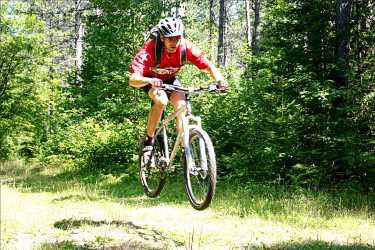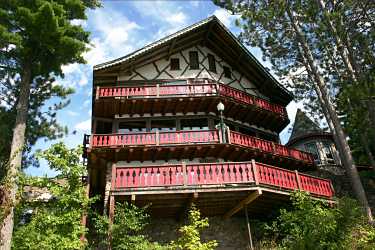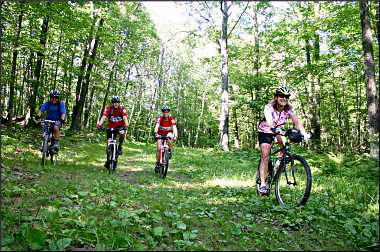Mountain biking in Hayward and Cable
In the forest of northwest Wisconsin, navigate a singular system of singletrack.

© Beth Gauper
In the forest around Hayward and Cable, it's easy to catch speed fever.
This is where the world's best Nordic skiers compete on the Birkie Trail, famous for its relentless ups and downs, and mountain bikers race on the CAMBA trails, known for 270-degree switchbacks and such obstacles as a boulder called the Volkswagen.
In this pocket of northwest Wisconsin, endurance athletes streak through Chequamegon National Forest year-round, training for the next big race on more than 300 miles of marked trails.
So why would this be a good place for a beginner to try mountain biking? I wondered that myself as I aimed my rented Rockhopper between trees, around stumps and over boulders.
By the time I figured out that mountain biking is kind of dangerous, I was already deep into the woods.
There was only one thing to do: Learn fast or crash.
There are trails for beginners, but they're on roads that seem dull once you've had a taste of singletrack. And it turns out that fat tires easily handle most stumps and rocks. It's the human brain that needs steering.
"My golden rule is, if you don't want to run into it, don't look at it," said Jodi, one of the friends coaching me. "It's the fear factor that can get you."
It was advice that could apply just as well to a tightrope walker. On a section of the 13-mile Makwa Trail, just northeast of Hayward, it was hard not to fixate on the rocks stacked on the edge of the trail.
They'd been put there by someone — but why?
We found out at one of the Makwa's many crossings of the Birkie Trail, where we ran into Harry Spehar, a member of the Chequamegon Area Mountain Bike Association board. He said the boulders had been taken out of the trail itself.
"We didn't want people to get in trouble," he said. "It's just not fun."
We rode the Birkie Trail, a rolling superhighway of grass, back to the Gravel Pit trailhead so we could ride west on an older section of the Makwa Trail. But suddenly, rocks and roots started popping up on the trail. It was as if we'd made a wrong turn onto a black-diamond trail from a blue.
That was the point where trail developers had "a different vision," said Joel Harrison, one of the owners of New Moon Bike & Ski Shop in Hayward. He'd rented us our bikes and given us a rundown of trails.

© Beth Gauper
On some trails, such as the Rock Lake Trail near Cable, he said, builders actually take rocks out of the woods and put them into the trail. Why?
"For fun, and because it's more challenging," he said. "There's one rock that's so big it's called the Volkswagen. You have to do it fast; otherwise, you'll tip over on the top."
Others can simply go around it: "I'm not too proud to put my bike on my shoulder and walk through," Harrison said.
I was weaving my way through the forest just fine until, for no discernible reason, my front tire turned and I crashed onto my right shoulder. But I got up undamaged, except for a macho-looking tattoo of bicycle-chain grease on my leg.
"You may get scraped up a little and dirty, but you're not going to kill yourself riding like this," said our more-experienced friend Susie. "I always think about riding a road bike at 30 miles per hour, and then this — you'd have to hit your head in a really unlucky place to kill yourself at 6 miles an hour."
We rode nearly 20 miles that day, but it felt like 70.
For dinner, we drove to Cable for pizzas from the stone oven at The Rivers Eatery, joining a convivial group that included Gary Crandall, longtime director of the Chequamegon Fat Tire Festival, and Ned Zuelsdorff, director of the American Birkebeiner.
The two men are following in the footsteps of legendary promoter Tony Wise, who turned a little hill into the Mount Telemark ski area in 1947, brought the Lumberjack World Championships to Hayward in 1960 and, in 1973, started the Birkebeiner, which became North America's biggest Nordic-skiing race.
In 1983, he helped Crandall start the Fat Tire Festival, which became the largest mountain-biking event of its kind.
All endeavors in these little backwoods towns tend to be big. In 1949, two fishermen set world records for the biggest muskies that still stand, though some think the records should be for biggest fish tales.
In Hayward, a 143-foot-long fiberglass muskie rises above the Namekagon River at the National Fresh Water Fishing Hall of Fame. Next door, the town of 2,100 produces world-champion log-rollers and boom-runners at its Lumberjack Bowl.
Boom running is a lumberjack sport that involves crossing a river on a bobbing line of logs. It's a lot like riding singletrack, in fact — you'd better keep your balance, or else.

© Beth Gauper
The next day, we rode on trails in the Namakagon "cluster" of trails, one of six in the CAMBA system. In the parking lot of the Namakagon Town Hall, 10 miles east of Cable, Scott demonstrated a standing stop, remaining upright on his bike yet motionless.
"That's good for when the person in front of you has just crashed," Susie said helpfully.
Of the nine cars in the lot, only two were from Wisconsin; the rest had Minnesota plates. CAMBA has been building trail since 1993, and its well-marked, well-maintained system draws riders from all over the region and, increasingly, the nation.
We headed south on the Patsy Lake Trail, which was easy singletrack and grassy doubletrack. It was a beauty, passing lakes and bogs, crossing beaver dams on boardwalks and taking us through patches of raspberries, ready for picking.
It still had its share of rocks, however, and when my husband got tired and coasted, his pedal hit one, twisting his tire and sending him flying in exactly the same way I had, onto his right shoulder.
That, said Scott, is "normal."
Despite mountain biking's reputation as a testosterone-charged sport, we saw only couples and families on the singletrack; the only young men we saw were riding on the wide Birkie Trail.
"In the beginning, it had an outsider status," said Susie, who bought her first mountain bike in 1987. "It was to road biking what snowboarding was to skiing."
Today, any one can ride. All you have to do is wear a helmet, watch the trail for rocks and be willing to sweat.
And if you stumble over that learning curve, don't worry: It's normal.
Trip Tips: Mountain biking around Hayward and Cable
Getting there: Cable is 1½ hours southeast of Duluth. Hayward is 2½ hours northeast of the Twin Cities. They're half an hour apart.
Annual events: Third Saturday of September, Chequamegon Fat Tire Festival.
For more about the area, see High color in Cable and Unwinding in Hayward.
Mountain-biking: The CAMBA trails include more than 300 miles of marked and mapped routes in six clusters around the towns of Hayward, Seeley, Cable, Drummond, Delta and Namakagon.

© Beth Gauper
There's no fee, but donations are welcome. CAMBA membership includes a set of trail maps, newsletters and invitations to special events.
Beginners will like the 14-mile Patsy Lake Trail south of the village of Namakagon. Maps are available at trailheads and sports shops. Be sure to wear a helmet.
Rentals: New Moon, on U.S. 63 just north of Hayward, rents mountain bikes and recommends trails. Reserve in advance for weekends, 800-754-8685. On Hayward's Main Street, Riverbrook also rents mountain bikes.
Accommodations: Seeley is midway between Hayward and Cable, making the Lenroot Lodge very convenient. It has 10 attractive rooms and is next to Mooselips Java Joint.
Just south of Cable, Bayfield County rents a yurt that has direct access to the CAMBA trails and sleeps six. Access is by foot by bike only.
There are several good places to stay east of Cable, off County Road M.
Cable Nature Lodge, seven miles east of Cable, has seven rooms.
Garmisch USA, 10 miles east of Cable on Namekagon Lake, has seven rooms and a suite in the lodge and 12 guest homes, including the five-bedroom, five-bathroom Blarney Castle. Its atmospheric restaurant serves German cuisine and has a great view of the lake.
Big Lakewoods Resort also is on Namekagon Lake and has a golf course and cottages and condos as well as hotel rooms.
Camping: Chequamegon National Forest has many places to camp, including the Namekagon Campground, 17 miles east of Cable on Namekagon Lake. They don't have showers, but many of the large resorts, including Lakewoods and Telemark, allow campers/mountain bikers to use their showers and pool areas for a small fee.
There are also primitive national-park campsites at landings along the Namekagon River between Cable and Hayward, which is part of the St. Croix National Scenic Riverway.
Dining: In Cable, The Rivers Eatery serves excellent 9-inch thin-crust pizzas baked in a stone oven. It also sells craft beers and wine and is the gathering spot for local silent-sports aficionados. Next door, the Ideal Market sells soups, sandwiches and frozen yogurt. They're closed Mondays.
In Hayward, the pleasant Angry Minnow on Florida Avenue serves its own beers as well as many sandwiches and such dishes as stuffed quail and pork and crayfish.
Nightlife: There's often live entertainment at the Wine Cave in Hayward.
In Seeley, Mooselips Java Joint sometimes has music.
Information: Hayward Lakes tourism, 800-724-2992. Cable tourism, 800-533-7454.